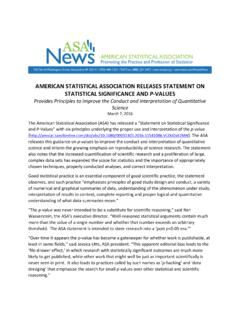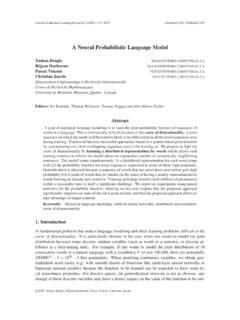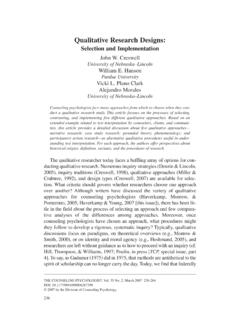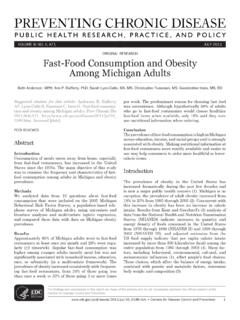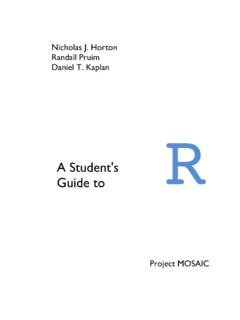Transcription of Statistical Education of Teachers
1 1 | Statistical Education of Teachers StatiSticalChristine A. Franklin (Chair)University of GeorgiaAnna E. BargagliottiLoyola Marymount UniversityCatherine A. CaseUniversity of FloridaGary D. KaderAppalachian State UniversityRichard L. ScheafferUniversity of FloridaDenise A. SpanglerUniversity of GeorgiaSTATISTICALEDUCATION OF Teachers SETP reface ..iChapter 1: Background and Motivation for SET Report ..1 Chapter 2: Recommendations ..5 Chapter 3: Mathematical Practices Through a Statistical Lens ..9 Chapter 4: Preparing Elementary School Teachers to Teach Statistics ..13 Chapter 5: Preparing Middle-School Teachers to Teach Statistics.
2 21 Chapter 6: Preparing High-School Teachers to Teach Statistics ..29 Chapter 7: Assessment ..39 Chapter 8: Overview of Research on the Teaching and Learning of Statistics in Schools ..45 Chapter 9: Statistics in the School Curriculum: A Brief History ..55 Appendix 1 ..61 Appendix 2 ..77 Contentsi | Statistical Education of Teachers PrefaceThe Mathematical Education of Teachers (MET) (Conference Board of the Mathematical Sciences [CBMS], 2001) made recommendations regarding the mathematics PreK 12 Teachers should know and how they should come to know it. In 2012, CBMS released MET II to update these recommendations in light of changes to the educational climate in the intervening decade, particularly the release of the Common Core State Standards for Mathematics (CCSSM) (NCACBP and CCSSO, 2010).
3 Because of the emphasis on statistics in the Common Core and many states guidelines, MET II includes numer-ous recommendations regarding the preparation of Teachers to teach report, The Statistical Education of Teachers (), was commissioned by the American statisti -cal Association (ASA) to clarify MET II s recommen-dations, emphasizing features of Teachers Statistical preparation that are distinct from their mathemati-cal preparation. SET calls for collaboration among mathematicians, statisticians, mathematics educa-tors, and statistics educators to prepare Teachers to teach the intellectually demanding statistics in the PreK 12 curriculum, and it serves as a resource to aid those report (SET) aims to do the following: Clarify MET II s recommendations for the Statistical preparation of Teachers at all grade levels.
4 Elementary, middle, and high school Address the professional development of Teachers of statistics Highlight differences between statistics and mathematics that have important im-plications for teaching and learning Illustrate the Statistical problem-solving process across levels of development Make pedagogical recommendations of particular relevance to statistics, includ-ing the use of technology and the role of assessment Chapter 1 describes the motivation for SET in de-tail, highlighting ways preparing Teachers of statistics is different from preparing Teachers of 2 presents six recommendations regard-ing what statistics Teachers need to know and the shared responsibility for the Statistical Education of Teachers .
5 This chapter is directed to those in leader-ship positions in school districts, colleges and uni-versities, and government agencies whose policies affect the Statistical Education of 3 describes CCSSM as viewed through a Statistical lens. Chapters 4, 5, and 6 give recommendations for the Statistical preparation and professional de-velopment of elementary-, middle-, and high-school Teachers , respectively. These chapters are intended as a resource for those engaged in teacher prepara-tion or professional 7 describes various strategies for assess-ing Teachers Statistical content 8 provides a brief review of the research lit-erature supporting the recommendations in this 9 presents an overview of the history of statistics Education at the PreK 12 1 includes a series of short examples and accompanying discussion that address particu-lar difficulties that may occur while teaching statis-tics to Teachers .
6 Appendix 2 includes a sample activity handout for the illustrative examples presented in Chapters 4 6 that could be used in professional development courses or a Resources The ASA provides a variety of outstanding and timely resources for Teachers , including record-ed web-based seminars, the Statistics teacher Network newsletter, and peer-reviewed lesson plans PREFACES tatistical Education of Teachers | ivPreface(STEW). These and other resources are available at National Council of Teachers of Mathematics (NCTM) offers exceptional classroom resources, includ-ing lesson plans and interactive web activities.
7 NCTM has created a searchable classroom resources site that can be accessed at #.AudienceThis report is intended as a resource for all involved in the Statistical Education of Teachers , both the ini-tial preparation of prospective Teachers and the pro-fessional development of practicing Teachers . Thus, the three main audiences are: Mathematicians and statisticians. Faculty members of mathematics and sta-tistics departments at two- and four-year collegiate institutions who teach cours-es taken by prospective and practicing Teachers . They and their departmental colleagues set policies regarding the sta-tistical preparation of Teachers .
8 Mathematics educators and sta-tistics educators. Mathematics ed-ucation and statistics Education faculty members whether within colleges of Education , mathematics departments, statistics departments, or other academ-ic units are also an important audience for this report. Typically, they are re-sponsible for the pedagogical Education of mathematics and statistics Teachers ( , methods courses, field experiences for prospective Teachers ). Outside of aca-deme, a variety of people are engaged in professional development for Teachers of statistics, including state, regional, and school-district mathematics specialists.
9 The term mathematics educators or sta-tistics educators includes this audience. Policy makers. This report is intended to inform educational administrators and policy makers at the national, state, school district, and collegiate levels as they work to provide PreK 12 students with a strong statistics Education for an increasingly da-ta-driven world. Teachers preparation to teach statistics is central to this effort and is supported or hindered by institutional policies. These include national accreditation requirements, state certifications require-ments, and the ways in which these require-ments are reflected in teacher preparation programs.
10 State and district supervisors make choices in the provision and funding of professional development. At the school level, scheduling and policy affect the type of learning experiences available to Teachers . Thus, policy makers play important roles in the Statistical Education of Teachers . v | Statistical Education of Teachers PrefaceTerminologyTo avoid confusion, the report uses the following terminology: Student refers to a child or adolescent in a PreK 12 classroom. teacher refers to an instructor in a PreK 12 classroom, but also may refer to prospective PreK 12 Teachers in a college mathematics course ( prospective teacher or pre-service teacher also is used in the latter case).


